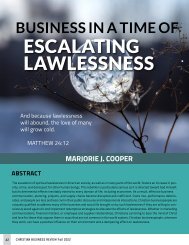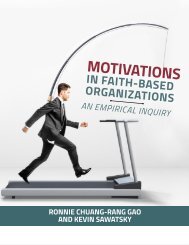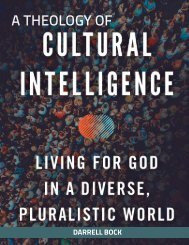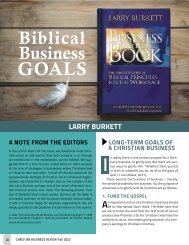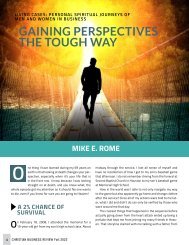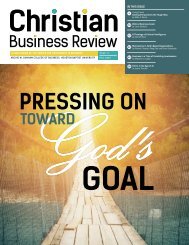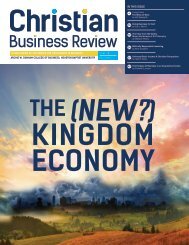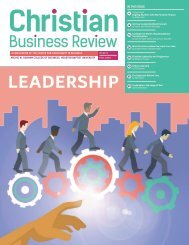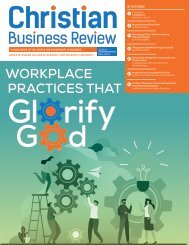Christian Business Review 2018: Kingdom Business in the Brave New World (Issue 7)
You also want an ePaper? Increase the reach of your titles
YUMPU automatically turns print PDFs into web optimized ePapers that Google loves.
commuication technologies<br />
allowed access to new talent or new customers, and created<br />
unprecedented collaboration across <strong>the</strong> world. These<br />
changes provide positive opportunities for us to create<br />
and extend relationships, but <strong>the</strong>y also create significant<br />
challenges. Because technology is chang<strong>in</strong>g at such a rapid<br />
pace, we are often unaware of <strong>the</strong> ways <strong>in</strong> which it affects<br />
us and our <strong>in</strong>teractions with o<strong>the</strong>rs.<br />
Assum<strong>in</strong>g that relationships and technology are both<br />
under God’s dom<strong>in</strong>ion, it is particularly important for<br />
<strong>Christian</strong>s to be attentive to how technology might impact<br />
our view of and communication with o<strong>the</strong>rs, as well as<br />
how we might utilize technology to be aligned with God’s<br />
purposes for us. We need to ask how technology <strong>in</strong>fluences<br />
relationships and to what extent <strong>the</strong>se impacts facilitate<br />
or h<strong>in</strong>der God’s <strong>in</strong>tent.<br />
Technology is “<strong>the</strong> totality of methods rationally arrived<br />
at and hav<strong>in</strong>g absolute efficiency <strong>in</strong> every field of human<br />
endeavor,” accord<strong>in</strong>g to Jacques Ellul. 1 Often, though<br />
not always, it is associated with <strong>the</strong> application of science<br />
to achieve some practical end. The term “technology”<br />
has often been used to refer to <strong>in</strong>formation technology<br />
or digital devices, but <strong>the</strong> subject is much bigger. There<br />
are implications of technology that we should be aware<br />
of if we want to understand <strong>the</strong> role of technology <strong>in</strong> our<br />
lives. We will highlight two: one that applies to technology<br />
generally, and one specific to <strong>in</strong>formation technology.<br />
First, technology has un<strong>in</strong>tended consequences. 2<br />
A technology created to solve one problem might later<br />
solve a different problem. The automated teller mach<strong>in</strong>e<br />
(ATM) was created to shorten <strong>the</strong> l<strong>in</strong>es <strong>in</strong>side a bank, but<br />
it ultimately resulted <strong>in</strong> <strong>the</strong> advent of 24-hour bank<strong>in</strong>g<br />
when it was moved outside <strong>the</strong> bank build<strong>in</strong>g. Conversely,<br />
a technology used to solve one problem can create a<br />
different problem. The automobile improved <strong>the</strong> ability<br />
to move from place to place <strong>in</strong> a timely way, but also<br />
<strong>in</strong>troduced pollution, traffic accidents, and so forth. The<br />
same technology used for good (driv<strong>in</strong>g to see friends)<br />
can be used for evil (bank robber’s getaway car), and various<br />
technologies can be comb<strong>in</strong>ed to create someth<strong>in</strong>g<br />
completely new and altoge<strong>the</strong>r un-envisioned by <strong>the</strong>ir<br />
creators. For example, <strong>the</strong> computer chip, a modem, <strong>the</strong><br />
<strong>in</strong>ternet, and security technologies are comb<strong>in</strong>ed to make<br />
onl<strong>in</strong>e commerce possible. While we will never elim<strong>in</strong>ate<br />
un<strong>in</strong>tended consequences, we can evaluate what might<br />
go wrong <strong>in</strong> <strong>the</strong> use of technology, and seek to mitigate<br />
aga<strong>in</strong>st <strong>the</strong> potential misuse of <strong>the</strong> technology. Certa<strong>in</strong>ly<br />
after <strong>the</strong> evidence of misuse is recognized, we can seek to<br />
manage it. For example, debat<strong>in</strong>g someth<strong>in</strong>g <strong>in</strong> email may<br />
lead to divergence of understand<strong>in</strong>g, and a face-to-face<br />
conversation may be better to resolve a misunderstand<strong>in</strong>g.<br />
Second, <strong>in</strong>formation technology <strong>in</strong> particular has a<br />
very high pace of change. Moore’s law says that every<br />
two years <strong>the</strong> number of transistors per square <strong>in</strong>ch will<br />
double. 3 Roughly <strong>in</strong>terpreted, this means that every two<br />
years any device dom<strong>in</strong>ated <strong>in</strong> cost by <strong>the</strong> transistor will<br />
CBR PEER REVIEWED ARTICLES<br />
ei<strong>the</strong>r drop by a factor of two for <strong>the</strong> same performance,<br />
or double <strong>in</strong> performance for <strong>the</strong> same price. When comb<strong>in</strong>ed<br />
with un<strong>in</strong>tended consequences discussed above,<br />
this means that completely new ways of do<strong>in</strong>g th<strong>in</strong>gs can<br />
appear almost overnight. This has two important consequences:<br />
1) S<strong>in</strong>ce people absorb change at different rates,<br />
<strong>the</strong>re will be some people who quickly get on board <strong>the</strong><br />
new way of do<strong>in</strong>g th<strong>in</strong>gs, while o<strong>the</strong>rs (for reasons of priority,<br />
cost, or learn<strong>in</strong>g) are left beh<strong>in</strong>d. This suggests we<br />
should make relationships a significant factor <strong>in</strong> decid<strong>in</strong>g<br />
whe<strong>the</strong>r or not to use a given technology. Ra<strong>the</strong>r than use<br />
video conferenc<strong>in</strong>g because we can, we should ask what<br />
might be miss<strong>in</strong>g <strong>in</strong> how we relate to each o<strong>the</strong>r, and seek<br />
o<strong>the</strong>r solutions to fill <strong>in</strong>; and 2) Each new opportunity<br />
opens <strong>the</strong> possibility for exploitation that can be used by<br />
those with nefarious <strong>in</strong>tent. There is a time lag, sometimes<br />
significant, between when someone discovers a way to<br />
exploit <strong>the</strong> technology and when o<strong>the</strong>rs uncover what is<br />
go<strong>in</strong>g on. Toxic mortgage-backed derivatives and <strong>the</strong> pollut<strong>in</strong>g<br />
effect of Volkswagen diesel eng<strong>in</strong>es are illustrations<br />
of this.<br />
While <strong>the</strong> un<strong>in</strong>tended consequences and high pace of<br />
change associated with technology will change <strong>the</strong> nature<br />
and types of our relationships, <strong>Christian</strong> <strong>the</strong>ology provides<br />
a lens through which we can evaluate <strong>the</strong>se changes.<br />
In this paper we outl<strong>in</strong>e some <strong>the</strong>ological pr<strong>in</strong>ciples that<br />
undergird our understand<strong>in</strong>g of what God <strong>in</strong>tends for relationships,<br />
as well as ways that our relationships are ei<strong>the</strong>r<br />
consistent or <strong>in</strong>consistent with God’s <strong>in</strong>tentions. We <strong>the</strong>n<br />
discuss ways <strong>in</strong> which communication technology can amplify<br />
both positive and negative aspects of relationships,<br />
provid<strong>in</strong>g examples from <strong>the</strong> workplace. F<strong>in</strong>ally, we summarize<br />
our conclusions about ways that <strong>Christian</strong>s could<br />
th<strong>in</strong>k about and engage with technology, and we discuss<br />
some areas where future research would be useful.<br />
Theological Values Undergird<strong>in</strong>g<br />
Relationships and Technology<br />
Before we turn our attention to a discussion of relationships<br />
and <strong>the</strong> ways <strong>in</strong> which technology can <strong>in</strong>fluence<br />
<strong>the</strong>m, we need to start with an overview of some <strong>the</strong>ological<br />
pr<strong>in</strong>ciples that help us understand God’s <strong>in</strong>tent for<br />
both technology and relationships. While <strong>the</strong>re are a large<br />
number of <strong>Christian</strong> scriptures that have implications for<br />
technology and relationships, <strong>in</strong> this section we focus on<br />
three pr<strong>in</strong>ciples from <strong>the</strong> creation narrative that are critical,<br />
as well as some additional concepts emphasized <strong>in</strong> <strong>the</strong><br />
<strong>New</strong> Testament. 4<br />
Implications from Creation<br />
First, we learn from <strong>the</strong> open<strong>in</strong>g chapters of Genesis that<br />
humans are created <strong>in</strong> God’s image: “[In] <strong>the</strong> image of<br />
God he created <strong>the</strong>m. Male and female he created <strong>the</strong>m.” 5<br />
While this can mean many th<strong>in</strong>gs, most agree that it places<br />
CHRISTIAN BUSINESS REVIEW fall <strong>2018</strong> 13





